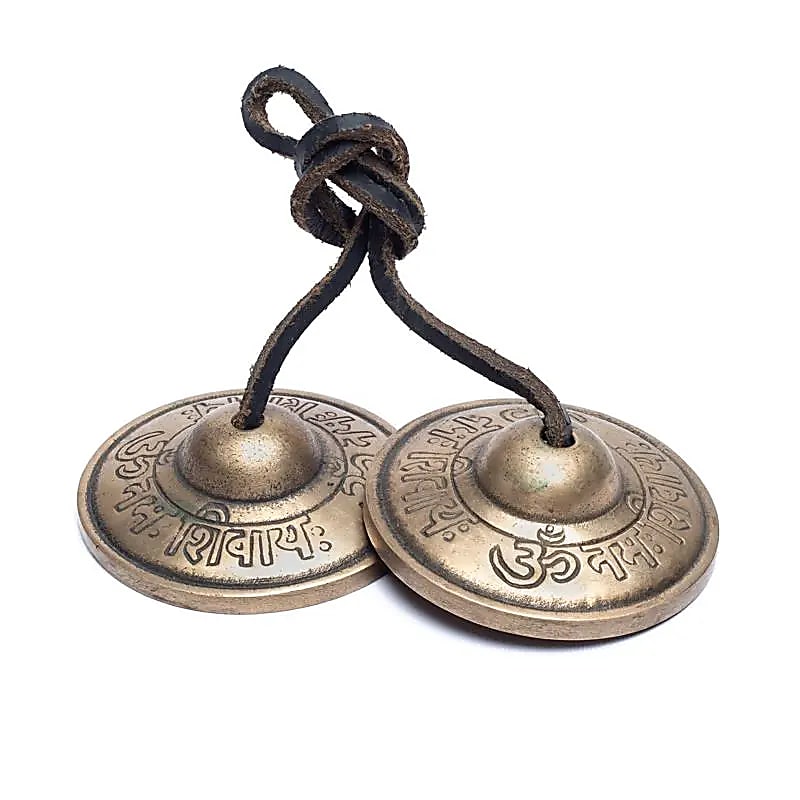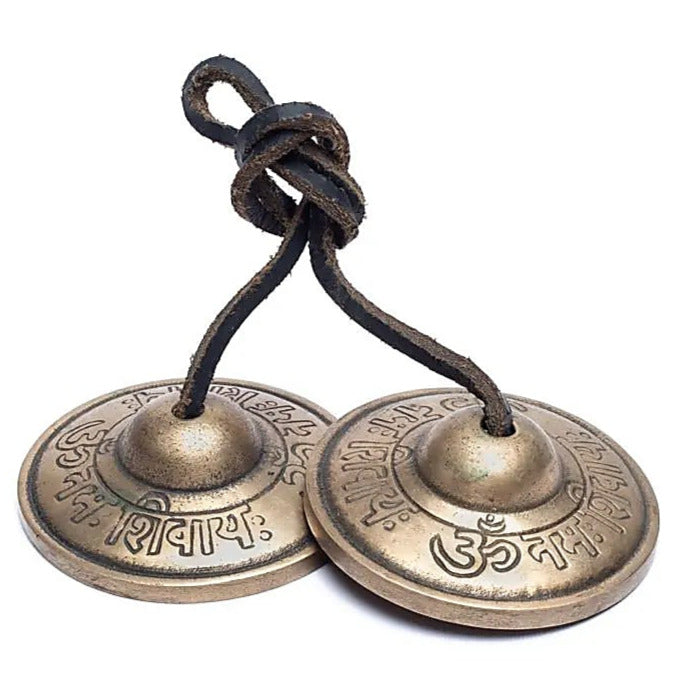Tibetan Cymbal/Tingsha, with engraving of the Mantra 'Om Namah Shivaya', 6.5 cm. They are used as musical offerings!
Tibetan Cymbal/Tingsha, with engraving of the Mantra 'Om Namah Shivaya', 6.5 cm. They are used as musical offerings!
Couldn't load pickup availability
- ✧─────✧
About the product:
→ Tibetan Cymbal - Tingsha - Ding-Sha's
🌍 Origin: Nepal - Tibet - Bhutan - China
📐 Dimensions/ ⚖️ Weight:
- Reference 19152 = 6.5 centimeters - +/- 185 grams
🧬 Materials: Copper + Bronze
📦 Packaging: Per pair
🎁 Ideal for giving as a gift or treating yourself!
🏷️ Option: If you want covers in typical Nepalese brocade: Click here
→ See all Tingsha models: Click here
🎶 An Asian percussion instrument often used by dancers including belly dancers.
They are small without any specific tone.
They are usually attached to the thumb and middle finger of one or both hands and struck together in a specific rhythm that usually accompanies other instruments.
These cymbals are an excellent instrument for developing a sense of rhythm, and/or improving it in children and adults. They are mainly used in sets of 2 at a time, one for each hand.
The mantra "Om Namah Shivaya" is one of the best known and most powerful in the Hindu and yogic tradition.
🔹 Meaning
- Om : the primordial sound, universal vibration.
- Namah : I bow, I pay homage.
- Shivaya : to Shiva, divine principle of transformation and liberation.
👉 Together, “Om Namah Shivaya” means:
“I bow to Shiva,” or more profoundly, “I honor the inner divinity and universal consciousness.”
🔹 Origin
- It is a panchakshara mantra (mantra in 5 syllables: Na-Ma-Shi-Va-Ya).
- It is directly linked to Shiva, god of transformation, letting go and renewal.
- It is found in the Vedas and the traditions of Shaivism .
🔹 Benefits of Recitation
- Soothes the mind and releases stress.
- Helps to detach from negative thoughts and the mind.
- Purifies energy and promotes deep meditation.
- Connect to one's inner divine nature.
- It is said that repetition of this mantra can lead to spiritual liberation (moksha) .
🔹 How to practice it
- Traditionally recited 108 times using a mala (string of beads).
- Can be sung aloud (kirtan), whispered or mentally repeated (japa).
- To practice in meditation, or even on a daily basis to stay centered and calm.
📋 Fact sheet:
| Category | Information |
|---|
| Name | Finger cymbal (or tingsha ) |
| Matter | Copper + Bronze Alloy |
| Diameter | 6.5 cm |
| Weight | 185 g (pair) |
| Origin / Use | Tibetan and Buddhist tradition – used for meditation, ritual and refocusing and Feng-shui |
| Sound | Clear, crystalline and penetrating tone, which purifies space and refocuses the mind |
| Use | - Start or end of meditation 🧘♀️ - Energy cleaning of the premises - Support for breathing and concentration work - Sound harmonization in vibrational therapy |
| Special feature | Small size, lightweight and easy to carry, ideal for personal use or travel |
| Symbolic | The sound of the tingsha cymbals is considered a sacred vibration , capable of bringing one back to the present moment and raising energy. |
- ✧─────✧
A question? A comment? | Order and delivery information
A question? A comment? | Order and delivery information
⋯⋯⋯⋯⋯⋯⋯⋯⋯⋯⋯⋯⋯⋯⋯⋯⋯⋯⋯⋯
📞 Customer service available from Tuesday to Saturday , from 10am to 7pm (French time)
- 🇫🇷 From France: 06 51 85 38 18
- 🌍 From abroad: +33 6 51 85 38 18
- 💬 Live chat: via the bubble in the bottom right corner of your screen
- 📧 Email : available 24/7 – we respond quickly!
⋯⋯⋯⋯⋯⋯⋯⋯⋯⋯⋯⋯⋯⋯⋯⋯⋯⋯⋯⋯
🔖 Order today and receive your package within 2 to 10 days depending on your continent.
💳 Secure payment & certified by SSL encryption 🔐
↩️ Returns & exchanges possible within 14 to 30 days after receipt.
🌍 Shipping costs are calculated automatically based on your shipping address at checkout.
📦 Country of shipment: France 🇫🇷
Share





